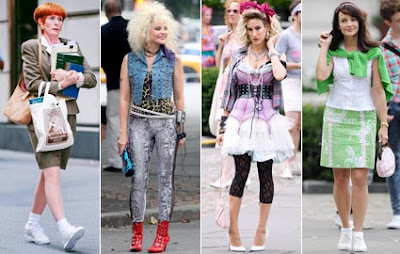new posts in all blogs
Viewing: Blog Posts Tagged with: Flashbacks, Most Recent at Top [Help]
Results 1 - 15 of 15
How to use this Page
You are viewing the most recent posts tagged with the words: Flashbacks in the JacketFlap blog reader. What is a tag? Think of a tag as a keyword or category label. Tags can both help you find posts on JacketFlap.com as well as provide an easy way for you to "remember" and classify posts for later recall. Try adding a tag yourself by clicking "Add a tag" below a post's header. Scroll down through the list of Recent Posts in the left column and click on a post title that sounds interesting. You can view all posts from a specific blog by clicking the Blog name in the right column, or you can click a 'More Posts from this Blog' link in any individual post.
 |
| Backstory |
We sometimes begin our stories
in medias res, in the midst of things, with no preamble as to who these characters are, or how this situation developed. It's often a good strategy, and can help capture a reader in the crucial early pages of a book.
A competing strategy for a writer is to first spend some time characterizing the protagonist(s), the principal problem(s) he faces, and the obstacles or opponents he must overcome. In this strategy, a tendency exists for the writer to load the development of a story with too much detail, before a reader might even have had a chance to become invested in the characters or the problem of the story.
Depending on our chosen writing strategy, if we need to reveal some important facet of the character's life, or the development of the problem, before the time of the narrative, i.e., a backstory, the writer will often resort to a 'flashback.' The flashback can be as short as a few sentences, or it might encompass an entire chapter embedded within the narrative of the current story. Regardless, an effective flashback can be difficult to use without disturbing the '
fictional dream' (John Gardner,
The Art of Fiction) for the reader, and possibly losing our reader.
It was interesting to note how how author Marilynne Robinson addressed the absence of any backstory for an otherwise quite interesting character, Lila, who appeared in
Gilead, her 2005 Pulitzer Prize winning novel. Lila was an intriguing young woman who appeared out of nowhere to marry a much older preacher in this spare, beautifully written story set in the mid-ninteenth century Iowa plains.
Robinson devoted a subsequent novel,
Lila, to explain this unique woman. I'm in the middle of reading it, and a confluence of yesterdays's life drawing session, see my watercolor sketch above, and this week's evening readings of
Lila, gave rise to the musings about a use of backstory in fiction. I hope it's been interesting.
START YOUR NOVEL
Six Winning Steps Toward a Compelling Opening Line, Scene and Chapter

- 29 Plot Templates
- 2 Essential Writing Skills
- 100 Examples of Opening Lines
- 7 Weak Openings to Avoid
- 4 Strong Openings to Use
- 3 Assignments to Get Unstuck
- 7 Problems to Resolve
The Math adds up to one thing: a publishable manuscript.
Download a sample chapter on your Kindle.
When you are deep into plotting a new novel or especially, a series, timelines are your friends. It’s a tool that will help straighten out the details and create order.
Obviously, a time line lays out the time period of your novel. Does it take place in 24 hours or does it span 24 years? Within that time span, you’ll want to slot events, reactions, and characters.
Backstory. Using a time line to plan a story probably means you’ll want to include back story events. You can do as much or as little as you need here. Maybe you want to include a character’s birth, baptism or bar mitzvah, high school graduation, or other major life events. You’ll also want to include other major events: parent’s divorce, house burned down, moving to a new school or city, first job and so on.
You can choose to do a separate time line for each person, but I like to have a master timeline where each character’s events are included. If you like, you can get fancy with this and do it on a spread sheet with each character getting a column or a certain color row.
Plot Events. When the events reach the story’s opening, it’s time to start imposing some structure. Dividing the time line into Act 1, 2 and 3 (and 4, if you use that paradigm), makes sense. You’ll want to make sure the story’s time line provides characters a great stage entrance, then introduces events that keep the story rolling. Here’s a great place to start tweaking the pacing of your story.

Ticking Clocks. Speaking of pacing, try introducing a ticking clock: some event must be completed by midnight or unspeakably bad things will happen. If Sherlock Holmes doesn’t solve the crime by midnight, beautiful Aurelia will be the victim of Poe’s pendulum (to mix up a lot of things!).
Edit and Revise. This is also a place where you should edit drastically. If you think up a scene, but can’t decide where to put it–cut it. It’s probably not important to the story anyway. Each scene or event should serve a definite purpose that pulls the reader toward the climactic ending. Some events will have a quiet purpose like characterization or setting p the next scene. OK, as long as there’s some purpose to the scene. Time enough later to Kill-Your- Darlings when you revise the novel.
Messing with the TimeLine. Now that you have the time line laid out, you can actually mess with it, if you like. You could present scenes out of order, with back story coming in as a flashback or even more drastic manipulations of time. The movie, Memento, is about a character with a short term memory problem, which lead to strange time manipulations. If you want to do this, be warned: the younger the audience, the more likely you are to confuse them. Telling a story with a jumbled timeline makes it harder for your reader to understand and enjoy. So, if you decide to go this route, use your best storytelling techniques. Read about flashbacks here or here.

<!--StartFragment-->
As I make my way through Shelley Pearsall’s new novel, Jump
Into the Sky—I’m almost halfway through the WWII story about a young boy in
search of his father—I can’t help admiring how she uses flashbacks as a way of
deepening the reader’s emotional connection to Levi Battle, the 13-year-old boy
who serves as her main character.
It isn’t easy for an author to find just

By: Kathy Temean,
on 9/4/2012
Blog:
Writing and Illustrating
(
Login to Add to MyJacketFlap)
JacketFlap tags:
Tips,
Advice,
Voice,
Process,
revisions,
Pacing,
authors and illustrators,
Flashbacks,
need to know,
demystify,
Manuscript Critiquing,
Writing Style Check List,
Add a tag
 Yesterday we looked at nine elements to check when doing a critique of your own manuscript or someone elses. Today we are going a step further by reading with Writing Style in mind. I want to thank Anita Nolan for writing these ten writing style elements up, so we can refer to them while critiquing a manuscript.
Yesterday we looked at nine elements to check when doing a critique of your own manuscript or someone elses. Today we are going a step further by reading with Writing Style in mind. I want to thank Anita Nolan for writing these ten writing style elements up, so we can refer to them while critiquing a manuscript.
• Voice: Strong? Too passive?
• Any problems with point of view? If there are multiple points of view, are the POV changes handled well?
• Does the dialogue sound natural? Is the dialogue of each character distinct, or does everyone sound the same?
• Does the dialogue move the story forward?
• Were there too many “he said” dialogue tags, or awkward substitutes for “said?” (snarled, hissed.)
• As to back story: Is it woven into the story, or are there any info dumps or “As you know, Bob”s (use of dialogue to dump information into the story.)
• Is there too much narrative? Too many flashbacks?
• Are the sentences clear, or do they need to be reworded to improve clarity?
• Is the story well-paced, or does it slow in places?
• Is there plenty of white space, or is the writing dense? (In other words, are the paragraphs short and interspersed with dialogue, or are they long blocks of type running a half page—or more.)
Tomorrow, we’ll go over what to check, when reading a synopsis. You can find Anita Nolan at: www.anitnolan.com
Talk tomorrow,
Kathy
Filed under:
Advice,
authors and illustrators,
demystify,
need to know,
Process,
revisions,
Tips Tagged:
Flashbacks,
Manuscript Critiquing,
Pacing,
Voice,
Writing Style Check List 

One of my dear book loving friends - who is also a teacher! - sent me this hilarious link to "The Babysitter's Club: Where Are They Now? "
Now be forewarned, some of the predictions are a little depressing. For example, I refuse to believe that Claudia and Stacey could ever not be BFFs.
My favorite glimpses into their lives today? Kristy and Teach for America and Mary Anne and the internet. If you are a BSC fan, take a look. You'll laugh out loud at least once!
PS: Check out my favorite BSC site:
What Claudia Wore
 Watch your delivery of backstory ~ the story of what, in the past, made the character who they are today (in story time).
Watch your delivery of backstory ~ the story of what, in the past, made the character who they are today (in story time).
Writers want to cram everything right up front.
"I know all their history, why would I want to withhold it from the reader?"
"I wrote it that way."
"It's the good part."
Writers spend lots of time imagining and writing every little detail about a character's past, be it for a child or an adult. So, of course, writers want to tell everything right away. Perhaps, in the process, even show off a bit how clever they are. Until, one understands how curiosity works.
Not telling everything makes the reader curious. Curiosity draws the reader deeper into the story world. The reader wants to fill in the "who," "what," "how" (the "where" and "when" have already been clearly established right up front to ground the reader). They keep reading. This is good.
Tell the reader only what they need to know to inform that particular scene. This is especially true in the Beginning (1/4 mark). During the first quarter of the project, the character can have a memory. But, if you feel you just must inject a full-blown flashback, where you take the reader back in time in scene, wait until the Middle.
(PLOT TIP: If you're absolutely sure you absolutely have to include the flashback, try using one when you're bogged down in the middle of the middle.)
The Carrie Diaries by Candace Bushnell, Balzar + Bray, 2010, 400 pp, Realistic Fiction, ISBN: 0061728918"Having fun?" he asks."Sure," I say. I should be embarrassed, but I'm not. I hate the way girls are supposed to be embarrassed all the time and I decided a long time ago that I just wouldn't do it.The Carrie Diaries is supposed to be the story of Carrie
before she became the Carrie Bradshaw we all know and love. However, I am here to tell you that she has
always been
fabulous.
The high school version of Carrie is just starting to navigate the world of men. She falls head over heels for Sebastian Kydd, the new boy in school. And come on, with a name like that, who wouldn't fall in love a little? Sebastian is experienced, mysterious, and a few shades of dangerous. The fact that she managed to steal him from Donna LaDonna made the whole deal even sweeter. How can sweet, patient George from Brown hope to compare?
Of course, Carrie wouldn't be Carrie if she didn't have her girlfriends by her side. Mags, the Mouse, Lali, and Walt
(ok, one non-girlfriend!) may not all be the loyal-to-a-fault friends whom she eventually finds in Samantha, Charlotte, and Miranda... but they certainly keep things interesting!
One of the things I loved most about
The Carrie Diaries was that it gave us a glimpse into Carrie's family. I thought I was the ultimate Sex and the City fan, but I had no idea that her mother had died when she was young, leaving her with an overly-analytical father and two younger sisters. On the flip side... I just
read that, according to the 4th season of the television series, Carrie's father abandoned their family when she was 5. This inconsistency is not a huge deal in the grand scheme of her life, but it does make me wonder how closely Candace Bushnell followed her literary creation on the small screen.
For me, the absolute best part of The Carrie Diaries was the message that Carrie conveyed about men and sex. She reaffirmed, over and over, that while men can be fabulous, they should never make you change who you are. Of course, she pushed the boundaries of that personal rule herself a few times... but, we've all made mistakes in the name of love!
"I mean, it's kind of like you're more than a girl... It's like - you're a guy in a girl's body.""What?""Take it easy. I didn't say you looked like a guy. I meant you think like a guy. You know. You're kind of practical but tough. And you're not afraid to have adventures.""Listen, buster. Just because someone is a girl doesn't mean she can't be tough and practical and have adventures. That's the way most gir
First
The Baby Sitters Club, then
Animorphs, and now
Sweet Valley Twins... I feel like my past is coming back to life!
The new
Sweet Valley book is going to be called
Sweet Valley Confidential. Unlike
The Summer Before, this add-on to the series will find Jessica and Elizabeth in the future. At this point, they're 27!
For the full scoop
(and a shot of a soon-to-be-trendy Team Jessica t-shirt), head over to
Readergirlz!
And while you're waiting for
Sweet Valley Confidential, head over to
Forever Young Adult and check out their series of
Sweet Valley posts. Amazing, I tell you!
So Book Lovers, if I could have wished any re-make into being, it would have been
The BSC. However, I was pretty disappointed at all of the changes they made by going back in time and messing with the past. My second re-make wish would have undoubtably gone to
Sweet Valley, so I have very high hopes for Jessica and Elizabeth in the
future!
Let's start speculating, Book Lovers! Where will our favorite twins live? Where will they work? Will we get to see Todd Wilkins and Lila Fowler again? And just for the record... Team Jessica all the way.
We've talked all this week about the challenges of writing backstory in summary. Specific details about the past events of a novel may need to be given to the reader, but less is more. Don't tell too much, and be selective and succinct when choosing the details to reveal. But what happens when you need to show the reader a scene? Chances are you will consider writing a flashback.
Technically, a flashback is a shift in the narrative that temporary stops the forward motion of the story. The trick is, of course, to make sure that that temporary stop informs your narrative, rather than distracting from it.
Unlike prologues, I don’t mind flashbacks. In fact, they can deepen the reader’s understanding of a story by showing character emotions and plot twists. But again, less is more. If done too much, a flashback can stop the forward movement of the narrative arc. If done without specific clarity, a flashback and confuse readers, especially reluctant readers.
So, here’s a tip sheet for writing flashback:
- Use verb tense as a way of showing the change in time. If you novel is written in present tense, your flashback should be written in past tense. If the main body of your story is told in past tense, then begin your flashback in past perfect, but transition to simple past tense within two or three sentences.
- Make sure the reader clearly is grounded in the time and place of your flashback. Give them a sentence or two with information about where and when, but as with summary backstory, don’t give too much. After the flashback is over, again ground readers in the present with details of time and place.
- Does your flashback have some kind of trigger that makes the flashback work for the reader at precisely that moment. Maybe it follows a strong action scene, or maybe it follows a reversal in the story. Either way, think about the purpose of the flashback. Does it reveal character? Does it give the reader important information they must know? Does it somehow inform the present? And does it come at a point in the plot so that it is the natural consequence of a plot point or character action?
- Unless you are doing a time travel novel, the same rule applies here for both summary and scene. When in doubt, see if you can get the same information to the reader without using the flashback. If you can, skip the flashback and stay with the story.
- Finally, don’t start a story with a flashback. It’s like using a prologue, and you know how I feel about that.

Next week on the tollbooth, Kelly will be here. Enjoy the weekend. Anon. HH
 A problem I often find in the plot consultations I provide is the misuse of flashbacks.
A problem I often find in the plot consultations I provide is the misuse of flashbacks.
During a plot consultation, a writer outlines her historical novel to me. Before long, the story takes a u-turn into flashback. My immediate reaction is to refocus myself. I quickly scan the Plot Planner I am creating for her for what I know of the story so far ~ the time frame, the place, and the characters ~ in order to keep in perspective the time and place change.
If you've read Blockbuster Plots Pure & Simple, you know I am not a fan of flashback. Mostly, I dislike the whiplash effect, but also because I have seen too many writers, especially writers just starting out, overuse and abuse flashback. It is more difficult and takes more thought and creativity to integrate the pertinent backstory seamlessly into the front-story than it is to create a flashback. Flashback is a depiction of a past, literal experience. Full integration of back-story into front-story involves more nuance and skill.
Three plot tips when it comes to flashbacks:
1) If you feel you just have to have a flashback, wait to use it in the Middle of the story. By then, the reader has had time to ground themselves in the front-story and is better able to transition back and forth in time
2) A flashback is portrayed moment-by-moment in scene. Consider instead using a memory (summary)
3) If flashbacks are integral to the overall plot and structure, do like Audrey Niffenegger in The Time Traveler's Wife, make the story line non-linear and create the very structure of your story based on time jumps.
 Character makes the story. Character draws us into the story. The reader and the audience have to like the characters before they will commit to the story.
Character makes the story. Character draws us into the story. The reader and the audience have to like the characters before they will commit to the story.
A blah protagonist, passive, and pretty quiet (like writers often tend to be) makes for a blah, passive, quiet story.
To spice up the protagonist, give her a goal. The goal has to be specific and quantifiable. Gets her moving. Gets the story moving.
Give her something to do.
Start the story with a dramatic question:
Is she going to... or not? Will he.... or not? Did they... or not?
She takes steps necessary to answer the question.
A concrete goal gives protagonist action so the reader can react to what the character does rather than merely follow her internal monologue.
Get her moving. Let her actions define her.
Cut all flashbacks.
For more on goal setting:
- read my article in the March '10 issue of The Writer (on book stands mid-Feb.)

Watch your delivery of backstory ~ the story of what (in the past) made the characters who they are today (in story time).
Writers want to cram everything right up front.
"I know all their history, why would I want to withhold it from the reader?"
"I wrote it that way."
"It's the good part."
Writers spend lots of time imagining and writing every little detail about a character's past, be it for a child or an adult. So, of course, writers would want to tell everything right away. Perhaps, in the process, even show off a bit how clever they are. Until, one understands how curiosity works.
Not telling everything makes the reader curious. Curiosity draws the reader deeper into the story world. The reader wants to fill in the "who," "what," "how" (the "where" and "when" have already been clearly established right up front to ground the reader). They keep reading. This is good.
Tell the reader only what they need to know to inform that particular scene. This is especially true in the Beginning (1/4 mark). During the first quarter of the project, the character can have a memory. But, for a full-blown flashback, where you take the reader back in time in scene, wait until the Middle.
(PLOT TIP: If you're absolutely sure you absolutely have to include the flashback, try using one when you're bogged down in the middle of the middle.)
Writers, especially beginning writers, often find themselves wanting to blurt out everything up front. This often shows up as a flashback early on in the story to show the back story or event that first sent the protagonist off kilter.
Don't.....
Keep in mind throughout to pace the info you share with the reader. In each scene, only put in as much as is needed to inform that particular scene (this can include foreshadowing clues of what is to come, but don't overload the scenes.) Invite the reader in slowly, but with a bang. Keep curiosity high = creates a page-turner book!
Don't tease the reader, but don't give them everything. Allude to problems, tension, conflict, who the character truly is, but hold back from revealing the details. Curiosity is one of the most powerful ways to pull the reader deeper into the story.
Hold off with flashback and even memories, if you can get away with doing so, until the Middle (1/2).
Also, be careful how many characters you introduce at a time. Introduce slowly and keep names to a minimum -- make sure we meet the protagonist first and get a clear idea who she is and that this is her story before moving on to the secondary characters.
In which I reveal the depths of my childhood dorkiness.

Oh, the things I have found this week! My parents moved recently and sent me this:
17 boxes full of stuff from my childhood. The pile includes all my old books, every card anyone sent back RSVPing to my Bat Mitzvah, and a box I haven't opened yet which my sister has labeled "Jacqui: Toys From College."
Tonight I reached randomly into the first box and found treasure: my Names Notebook. For three years, I kept track of every single girl's name I could think of or came across. I wrote them all down in a black composition notebook, one letter of the alphabet per page, like this:
 There are 568 names in here, starting with Alison, ending with Zari, and passing Efraziti (which I have to use in a book someday) and Moon Unit ("as in Zappa!!!" I wrote), though not including Tinkerbell or her actual name. The cool thing is that I'm not positive why I decided to keep the Names Notebook, but I have a hazy memory that it was so that I'd have names for characters someday, if I ever, gasp, got to be a real, live author.
There are 568 names in here, starting with Alison, ending with Zari, and passing Efraziti (which I have to use in a book someday) and Moon Unit ("as in Zappa!!!" I wrote), though not including Tinkerbell or her actual name. The cool thing is that I'm not positive why I decided to keep the Names Notebook, but I have a hazy memory that it was so that I'd have names for characters someday, if I ever, gasp, got to be a real, live author.
Now, you may be thinking, "That's not so dorky." Just wait. Peruse briefly that first page where I have invented 45 punny names from "Idy Testchew" to "Bo Nannah." Now flip to the almost end of the notebook. No, not the last five pages, on which I seem to have written and solved long division problems involving fractions, apparently just for fun, which I then circled and numbered in order of difficulty. Go to the Z names, and then turn one further, which brings us to this:
 Yup. That's a dated running record of how many names I'd collected, including a key to the symbols I used to codify the words by spelling, uniqueness, and gender ambiguity. It's updated almost every time I added a new name. Note my excitement at 500. Yup, that says, "Let's party!!" Twice.
Yup. That's a dated running record of how many names I'd collected, including a key to the symbols I used to codify the words by spelling, uniqueness, and gender ambiguity. It's updated almost every time I added a new name. Note my excitement at 500. Yup, that says, "Let's party!!" Twice.
Don't laugh. At least I know my dork cred is legit. What you got?
And if you need names for your NaNoWriMo characters, you know where to come...
EDITED TO ADD:
Concerned I might either out-dork him or run off with Cindy (see comments) The Mighty Thor (failed Eagle Scout) admits: "You know how Boy Scouts have merit badges? I was unhappy with the merit badges that existed, so I made up 50 of my own. I designed actual badges for them and painted them onto cardboard circles so I could display them. These extra badges included such achievements as "Illuminati" (for playing the board game Illuminati well), "Communist" (where you learned a lot about Karl Marx), and "Calculus" (self-explanatory).
Oh my. Do we deserve each other or what?
Take a look at Dan P. Carr's daily paintings. His blogs has great art and links.




 Yesterday we looked at nine elements to check when doing a critique of your own manuscript or someone elses. Today we are going a step further by reading with Writing Style in mind. I want to thank Anita Nolan for writing these ten writing style elements up, so we can refer to them while critiquing a manuscript.
Yesterday we looked at nine elements to check when doing a critique of your own manuscript or someone elses. Today we are going a step further by reading with Writing Style in mind. I want to thank Anita Nolan for writing these ten writing style elements up, so we can refer to them while critiquing a manuscript.






Good advice on using flashbacks. (Please turn off your word verification for comments. If it doesn't post within two tries, I quit.)
Thanks, Richard, for the kind words... and for the tip on word verification. Glad you kept at it, and hope you won't encounter a problem in the future.